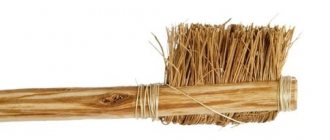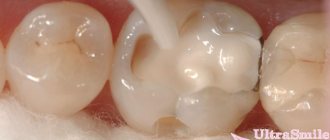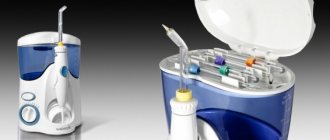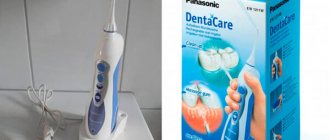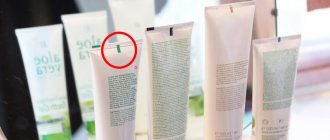Oral irrigators are a relatively new type of household appliance that has made home oral care fundamentally more effective. Devices from the Russian company Donfeel, which produces portable and tabletop irrigators, are in demand. For a family, a desktop or stationary household appliance with a greater safety margin than portable models is suitable. Let us examine in detail how the Donfeel OR-830, OR-820M and OR-820D compact devices differ from the point of view of technical parameters and equipment.
What types of irrigators are there?
An irrigator is a device that, by creating a pulsating stream of water, cleans the teeth, gums and tongue. Such devices began to be produced relatively recently, but every year they become more and more popular. Today they are recommended to their dental patients. Irrigators help maintain healthy teeth and gums, protecting against caries, periodontal disease, plaque, tartar, gingivitis and other problems. They are also suitable for caring for orthodontic structures: braces, implants, crowns, bridges and dentures.
There are three types of irrigators:
- flow-through;
- stationary;
- portable.
The first ones do not have a liquid reservoir. They are connected by a tube directly to the tap. These are the very first models that are now rarely used. Stationary and portable are equipped with water tanks. They are multifunctional, with several operating modes. These irrigators have a power switch that allows you to regulate the pressure and pressure of the jet. Portable and stationary devices can be used by almost everyone without restrictions: children, patients with sensitive gums, as well as people who have braces installed.
Waterpik models and their advantages
We offer stationary and portable irrigators for braces, which deliver a stream of water with 1200-1450 micropulses per minute. As a result of the formation of weak hydraulic shocks, plaque and food debris are effectively removed. Microimpulses have a comfortable and safe effect, massage the gums well, stimulate blood circulation, and remove plaque even in hard-to-reach places.
Features of different types of irrigators:
- Stationary. Devices with an enlarged water tank (500-1000 ml), powered by electricity. They are equipped with various nozzles, have greater power and the ability to adjust the liquid pressure, which allows you to effectively clean bracket systems, etc. The disadvantages include an increased level of noise and vibration.
- Portable. Compact and lightweight devices powered by rechargeable batteries or rechargeable batteries. They have a reservoir with a volume of 300-450 ml, which is enough for one procedure. Disadvantages - the need to recharge once every 5-7 days.
When determining which irrigator is best to choose for braces, you need to take into account the conditions of its use. For those who frequently travel on business, it is better to buy a portable model for cleaning dental structures in any conditions.
Irrigators for braces: orthodontic attachments
The irrigator can be equipped with various attachments. Main types:
- Standard. Suitable for routine cleaning of the oral cavity. It has a curved shape and a small diameter nozzle. With its help, 1-2 teeth are washed. It does not allow you to completely clean your braces.
- Massage room. Equipped with a round head with bristles designed to massage the gums, which helps stimulate blood circulation in the gums and strengthen the tissue. Doctors advise using an irrigator with massage attachments for people who wear braces. Metal elements cause discomfort and pain due to constant displacement of teeth. A light massage of the gums can reduce pain and speed up the regeneration process.
- Periodontal. Used to clean periodontal pockets. Indicated for periodontal diseases. Also suitable for cleaning braces.
- To remove plaque. These attachments are equipped with several tufts of bristles that remove deposits from teeth through mechanical action. A pulsating jet of liquid performs additional cleaning. Plaque removal attachments can be used to maintain braces.
- Orthodontic. Designed for cleaning any orthodontic structures. It has an elongated nozzle and a curved neck with a narrow tip, which allows you to penetrate hard-to-reach places, clean locks and places where braces come into contact with your teeth.
Stationary irrigators are produced with a large number of attachments. As a rule, the kit includes 1-2 standard ones and several special ones. They can be purchased separately, you just need to make sure that they fit your specific device model. Which irrigator should I buy for braces? Let us list the main selection criteria.
In what price segment and for what audience is the device intended?
Jetpik products belong to the high price segment , but the cost of the devices justifies the money spent.
The multifunctional device allows you to reduce the frequency of visits to the dental office and avoid many diseases of the oral cavity.
The price of Jetpik irrigators is formed from objective factors and is within affordable limits, and a wide range is designed to meet the needs of each consumer.
Irrigator for braces - how to choose
When buying an orthodontic irrigator, pay attention to the following points:
- For a family, choose a stationary irrigator with a large number of attachments and a large liquid reservoir. If you often travel on business, a portable model is suitable. However, the kit may not include an attachment for braces. They will have to be purchased additionally.
- Make a choice in favor of models with several operating modes. Such irrigators allow you to change the pressure level and jet pressure.
- Make sure the device is compatible with orthodontic attachments. Even if they are not included, it should be possible to attach them.
There is a separate nozzle for each family member. Typically, manufacturers mark them with different colors so that consumers do not confuse them and use only their own. We will describe popular models and advise which irrigator for braces is best to choose.
Features of application
The characteristics and equipment of irrigators are constantly being improved. But the design and operating schemes are almost the same in all devices and consist of a small hydraulic pump equipped with pressure control, as well as a container for liquid and nozzles, which are attached to a special handle.
The method of using all devices is the same, the only difference can be in the type of irrigator.
They can be divided into three categories:
- Stationary devices . These devices are connected to the network, attached to a surface with suction cups, or hung on the wall. Convenient for family use. A person simply plugs in the device, removes the handle from the stationary device, attaches the attachment, turns it on and uses it.
- Portable devices are compact and suitable for those who are often on the road. The device is already ready for use; just select the attachment and turn it on.
- Devices connected to the tap . They are simple, inexpensive, and the principle of use is similar to stationary ones.
Cleaning your mouth with an irrigator will not take you much time. The general usage pattern looks like this:
- brush your teeth with a regular toothbrush and toothpaste;
- install the nozzle and turn on the device;
- clean the oral cavity with a jet of liquid, paying attention to the interdental spaces, gum line and teeth, to achieve this, the jet tip should be directed perpendicular to the teeth (at a distance of 2-3 mm from them) and easily clasped by the lips, light holding will help the waste liquid flow out unhindered mouth
Rating of the best irrigators for caring for braces
The top best irrigators, which are approved by dentists and popular with buyers, include the following models:
- Donfeel OR-830;
- Waterpik WP-100 E2 Ultra;
- Aquajet LD-A8;
- Revyline RL200XL;
- B.Well WI - 912.
Each of these devices has its own advantages and disadvantages. Let's take a closer look at them.
Donfeel OR-830
A stationary irrigator that helps maintain healthy teeth and gums. It is suitable for almost everyone, including people with braces. The set includes 8 attachments: 3 standard, for implants, for tongue, nasal, periodontal and orthodontic. The device is equipped with a volumetric tank of 1000 ml. It is enough for a complete cleaning of the oral cavity for 3-4 family members.
The device is multifunctional. It has several operating modes. There is a power switch with which you can smoothly change the level of pressure and jet pressure from 80 to 680 kPa. The pulsation frequency is in the range of 1200-1700 beats per minute.
The irrigator has a unique option - ultraviolet cleaning of nozzles. By switching the toggle switch, you activate the UV lamp in the compartment for storing device components. Disinfection should be carried out once a week for seven minutes.
pros
- large set of nozzles;
- UV disinfection;
- spacious tank;
- long cable - 1.4 m;
- setting operating modes;
- side compartment for storing attachments.
Minuses
- no spray mode;
- bracket is missing;
- the nozzle does not rotate 360°.
Waterpik WP-100 E2 Ultra
A stationary irrigator, which comes with 7 attachments included: three standard ones, for caring for braces, implants and gum pockets, as well as a special brush for cleaning any orthodontic structures. The device is equipped with a medium reservoir with a volume of 650 ml, which is enough for two procedures. The device operates in the range of 70-690 kPa. It can be used by people with increased sensitivity of gums and enamel.
pros
- 4 nozzles for the care of orthodontic elements;
- spacious tank for several procedures;
- smooth device pressure switch;
- maximum pulsation frequency is 1400 per minute.
Minuses
- nozzles do not rotate around their axis;
- high cost of the model;
- There is no way to hang it on the wall.
Aquajet LD-A8
A stationary device with four attachments that can be used to care for braces and implants. One of them is designed for gum massage. All controls have a rubberized coating. The handle is comfortable to hold in your hands, it does not slip out and allows you to effectively clean the entire oral cavity. There is a compartment on the side for storing attachments.
pros
- presence of attachments for braces included in the kit;
- relatively low price;
- compact dimensions of the device.
Minuses
- small tank - 500 ml;
- no tongue cleaner;
- not suitable for hypersensitive gums.
Revyline RL200XL
A portable irrigator, which is indicated for the prevention of tartar formation, caries and periodontal disease. It can be used by people with braces, implants and veneers. The device is convenient to take on the road, it is compact and does not take up much space in your bag. At the same time, it is very powerful - 210-700 kPa - and creates up to 1800 pulsations per minute.
pros
- compact dimensions;
- high power;
- volumetric tank - 300 ml;
- Suitable for gum massage.
Minuses
- only two attachments included;
- not suitable for hypersensitive gums.
B.Well WI - 912
A portable irrigator that is not inferior in power to stationary ones. It creates pressure up to 720 kPa. The set includes 5 attachments, including one for caring for braces. The device operates in three modes:
- Normal: for daily use;
- Soft: for sensitive teeth and gums;
- Pulse: cleanses and massages the gums.
The device has another important advantage - the nozzle rotates 360°, which allows you to reach the most difficult to reach places.
pros
- 5 nozzles;
- 360° rotation;
- high power;
- 3 operating modes;
- affordable price.
Minuses
- The only drawback of the model is the small liquid reservoir - 150 ml. But the device is compact and lightweight.
Equipment
Irrigators produced by this company are supplied in an expanded configuration :
- Main device.
- Liquid supply hose.
- Pen.
- Charger.
- Power adapter.
- USB adapter.
- Jet nozzles.
- Toothbrush attachments.
- Smart Floss Cartridges.
- Tongue scraper.
- Glass with water supply function.
- Ultraviolet sterilizer.
- Case for storing the device.
- Detailed operating instructions.
- Warranty certificate.
- Box.
How to use a irrigator to clean braces
The procedure is carried out in front of a mirror above the sink. Fill the tank with water or a special balm and plug it into the mains if it is stationary. First you need to select a weak operating mode, and then increase the pressure and jet pressure. Direct the nozzle towards the teeth at an angle of approximately 80°, working on each tooth and hard-to-reach areas. Particular attention should be paid to locks and joints between the structure and the enamel. The procedure lasts 3-5 minutes. You can complete it with a gum massage, which is performed with another attachment.
On our website you can find a good irrigator that is suitable for caring for braces. When purchasing, make sure that the appropriate attachment is included in the package.
Features of irrigators from Jetpik
Developed by engineer Henry Hu , the cartridge contains a built-in floss that is ejected along with the liquid flow and cleans the tooth surface.
Smart Floss cleaning technology combines the capabilities of an irrigation jet and dental floss.
Studies have shown that the “smart thread” copes with its task several times better than a regular water jet.
In addition, when developing the design of the devices, the manufacturer thought through every detail and also created a unique design.
It is worth noting! Each Jetpik irrigator has the following characteristics:
- portable type of device;
- pulse operating principle;
- battery powered;
- step pressure adjustment;
- light weight (about 300 g);
- 25 minutes of continuous operation;
- Battery charging time – 5 hours;
- jet pulsation frequency – 1500 pulses per minute;
- tank volume – 400 ml;
- 6 operating modes;
- contactless charging;
- a large number of floss cartridges;
- jet nozzles;
- tongue cleaner;
- glass for supplying water;
- long warranty period.
For your information! Jetpik irrigators can be used by children. However, it is worth remembering that the procedure can only be carried out under adult supervision.
Personal acquaintance
We invite you to study the reviews of our visitors about the most popular models of Donfeel irrigators.
I have been using the OR-820M device for two years. Satisfied with the device. Cleans well, there are enough attachments for all family members. My husband uses it to rinse his nose, so he gets rid of the constant need to use nasal drops.
Maria, 36 years old
The circumstances were such that a year ago I had to have my teeth splinted. It is very difficult to clean such a structure well with a regular brush. Therefore, I purchased the OR 830 irrigator and I can say that in my case it is a necessary and irreplaceable thing.
Alexey, 43 years old
I was given a device for my birthday (OR-840 air). It copes well with its functions, we have been using it for more than six months now. Among the shortcomings I can highlight: the small capacity of the reservoir and the on/off button is a bit harsh for me.
Alla, 32 years old
